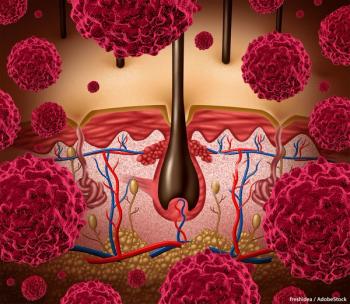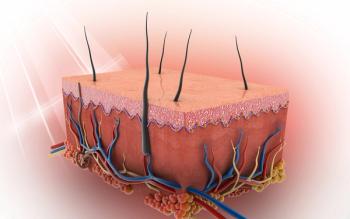
Oncology NEWS International
- Oncology NEWS International Vol 13 No 1
- Volume 13
- Issue 1
Antisense May Potentiate DTIC Efficacy
NEW YORK-Adding an antisense agent (oblimersen sodium, Genasense) to standard dacarbazine (DTIC) may significantly improve overall survival with only a slight increase in adverse effects, compared with DTIC alone, according to initial results from the largest-ever phase III trial in advanced metastatic melanoma. "We may have actually made a difference in overall survival in patients with metastatic melanoma," said researcher Anna C. Pavlick, DO, assistant professor of oncology, New York University School of Medicine.
NEW YORKAdding an antisense agent (oblimersen sodium, Genasense) to standard dacarbazine (DTIC) may significantly improve overall survival with only a slight increase in adverse effects, compared with DTIC alone, according to initial results from the largest-ever phase III trial in advanced metastatic melanoma. "We may have actually made a difference in overall survival in patients with metastatic melanoma," said researcher Anna C. Pavlick, DO, assistant professor of oncology, New York University School of Medicine.
The antisense/DTIC combination increased response rate and progression-free survival vs standard DTIC, data from the multicenter, randomized, double-blind trial show. Overall survival, in the subset of patients who have been followed for at least 12 months, was increased by 25% (see Figure), "although further follow-up is needed . . . since these are very preliminary data," Dr. Pavlick said at the Chemotherapy Foundation Symposium XXI.
The antisense agent targets bcl-2, a protein that is overexpressed in melanoma and other cancer types. Researchers believe that pretreating cancer patients with the agent may potentiate the cytotoxic effects of chemotherapy. "This trial clearly gives us proof of concept that Genasense can chemosensitize normally resistant tumors," Dr. Pavlick said.
The phase III trial enrolled 771 patients at 139 sites in 9 countries. Patients were randomized to receive up to eight cycles of DTIC alone at 1,000 mg/m2 on day 1, or Genasense 7 mg/kg for 5 days followed by infusion of DTIC 1,000 mg/m2 on day 6. Cycles were repeated every 21 days. Responders were allowed to receive another eight cycles of treatment in a continuation protocol. Responses were evaluated every two cycles.
The median age of the predominantly Caucasian patient population was approximately 60 years. However, some 40% of patients were over 65, a "geriatric population normally excluded from clinical trials that was able to tolerate this therapy without significant toxicity," Dr. Pavlick noted.
Mean time from melanoma diagnosis to metastatic disease was 2.5 years. Less than 10% of patients had locally advanced unresectable disease; the rest had metastatic melanoma. Approximately 40% of patients had received prior immunotherapy (either high-dose interferon as an adjuvant or vaccine therapy).
Nearly 50 patients in the Genasense/DTIC arm have gone beyond the initial eight cycles of treatment and into the eight-cycle continuation phase, data show. "In fact, I had one patient who received those 16 cycles and is considered a complete responder, and continues to be in complete response now approximately 2 years out," Dr. Pavlick said.
Survival Results
As of this report, overall survival in the entire cohort of 771 patients is not significantly different between the Genasense/DTIC and DTIC-only arms (estimated median survival of 9.1 and 7.9 months, respectively, P = .184). "Both groups did better than we had anticipated," Dr. Pavlick said. "Patients on the DTIC arm were expected to survive 6 months, when they, in fact, survived 7.9 months. The combination arm was predicted to survive 8 months, and, in fact, it was 9.1 months."
A surge of enrollment near the end of the trial meant that the overall survival curve is "not mature," Dr. Pavlick noted, with a mean follow-up of only 7 months. However, looking only at the 480 patients with follow-up of 12 months or longer, there is a significant difference in overall survival favoring the Genasense/DTIC arm (median survival of 10.1 vs 8.1 months, P = .035) (see Figure on page 2).
Estimated median progression-free survival for all 771 patients is 74 days for Genasense/DTIC vs 49 days for DTIC alone (P = .0003). Likewise, a significant difference in time to progression was seen.
Normal LDH was found to be the best prognostic indicator of progression-free survival, Dr. Pavlick said. Other prognostic indicators included no liver involvement, treatment with the antisense agent, female sex, and no prior immunotherapy. Age was not a significant prognostic indicator.
Overall tumor response was 11.7% (45 patients) in the Genasense/DTIC arm vs 6.8% (26 patients) in the DTIC-only arm (P = .0185); this included 5 complete responses in the combination arm and 2 in the DTIC arm. Counting patients with stable disease (about 30% in either arm), the total antitumor response rate was 41.7% in the combination arm and 34.3% for DTIC alone (P = .034).
Adding the antisense agent did not lead to a reduction in the chemotherapy dose. Cumulative DTIC dose was similar in the combination and DTIC-only arms (mean of 3,418 mg/m2 and 3,372 mg/m2, respectively).
Adverse event rates in the combination arm were "slightly higher" than in the DTIC-alone arm, Dr. Pavlick said: "It appears that the antisense agent may augment the expected side effects of the chemotherapy, namely neutropenia and thrombocytopenia, and maybe, to some extent, nausea, headache, and anorexia. Fever was also slightly more common in the antisense arm." The only serious adverse event seen in more than 5% of patients, however, was fever (5.9% vs 3.1% with DTIC-alone). "That is due to the fact that fever is attributed as a side effect of Genasense therapy," Dr. Pavlick said, "but . . . there is not a high percentage of serious adverse events, and patients did not come off study due to toxicity."
Articles in this issue
almost 22 years ago
Stopping Smoking May Increase Breast Cancer Survivalalmost 22 years ago
Neoadjuvant Anastrozole Permits Breast Conservationalmost 22 years ago
3D Virtual Colonoscopy as Sensitive as Conventional TestNewsletter
Stay up to date on recent advances in the multidisciplinary approach to cancer.


















































































